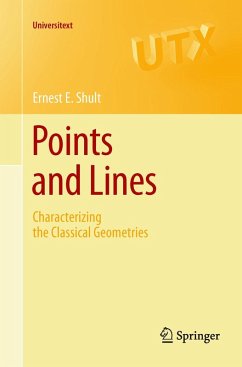The classical geometries of points and lines include not only the projective and polar spaces, but similar truncations of geometries naturally arising from the groups of Lie type. Virtually all of these geometries (or homomorphic images of them) are characterized in this book by simple local axioms on points and lines. Simple point-line characterizations of Lie incidence geometries allow one to recognize Lie incidence geometries and their automorphism groups. These tools could be useful in shortening the enormously lengthy classification of finite simple groups. Similarly, recognizing ruled manifolds by axioms on light trajectories offers a way for a physicist to recognize the action of a Lie group in a context where it is not clear what Hamiltonians or Casimir operators are involved. The presentation is self-contained in the sense that proofs proceed step-by-step from elementary first principals without further appeal to outside results. Several chapters have new heretofore unpublished research results. On the other hand, certain groups of chapters would make good graduate courses. All but one chapter provide exercises for either use in such a course, or to elicit new research directions.
Dieser Download kann aus rechtlichen Gründen nur mit Rechnungsadresse in A, B, BG, CY, CZ, D, DK, EW, E, FIN, F, GR, HR, H, IRL, I, LT, L, LR, M, NL, PL, P, R, S, SLO, SK ausgeliefert werden.
From the reviews:
"In this expansive volume, Shult (Kansas State Univ.) attempts to provide a thorough, self-contained characterization of geometries of Lie type by means of local axioms on points and lines. ... There is enough material here for several semester-long graduate courses; alternatively, the book could be used as a reference work. Shult makes every effort to remain chatty ... and intuitive while ensuring precision and detail. Summing Up: Recommended. Graduate students and researchers." (S. J. Colley, Choice, Vol. 48 (11), July, 2011)
"This book presents characterizations of the classical geometries of Lie type by axioms on points and lines; it is a teaching book with detailed proofs, written for beginning graduate students. ... Most chapters end with a set of exercises ... . The whole book shows the author's love of incidence geometry and of teaching." (Theo Grundhöfer, Mathematical Reviews, Issue 2011 m)
"Shult has designed the book as a self-contained resource for a graduate student who plans to pursue research in this area. ... the book gives detailed proofs and offers exercises at the end of each chapter, organized by topic. ... geometrically inclined readers will wish to illustrate the text, in addition to working through the official exercises. ... the intensity of detail and sparsity of illustrations make it more suitable as a handbook for experts ... ." (Ursula Whitcher, The Mathematical Association of America, July, 2012)
"In this expansive volume, Shult (Kansas State Univ.) attempts to provide a thorough, self-contained characterization of geometries of Lie type by means of local axioms on points and lines. ... There is enough material here for several semester-long graduate courses; alternatively, the book could be used as a reference work. Shult makes every effort to remain chatty ... and intuitive while ensuring precision and detail. Summing Up: Recommended. Graduate students and researchers." (S. J. Colley, Choice, Vol. 48 (11), July, 2011)
"This book presents characterizations of the classical geometries of Lie type by axioms on points and lines; it is a teaching book with detailed proofs, written for beginning graduate students. ... Most chapters end with a set of exercises ... . The whole book shows the author's love of incidence geometry and of teaching." (Theo Grundhöfer, Mathematical Reviews, Issue 2011 m)
"Shult has designed the book as a self-contained resource for a graduate student who plans to pursue research in this area. ... the book gives detailed proofs and offers exercises at the end of each chapter, organized by topic. ... geometrically inclined readers will wish to illustrate the text, in addition to working through the official exercises. ... the intensity of detail and sparsity of illustrations make it more suitable as a handbook for experts ... ." (Ursula Whitcher, The Mathematical Association of America, July, 2012)


